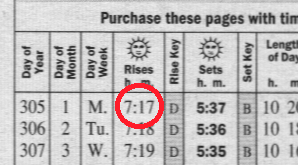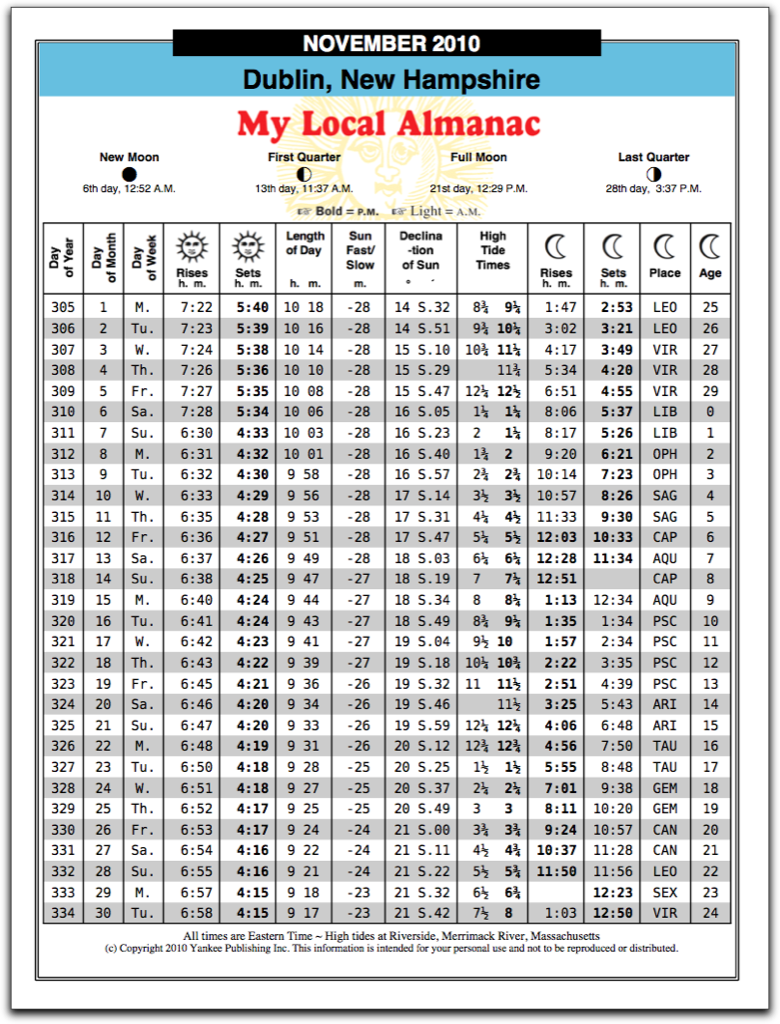Of all the projects I’ve had a hand in over the years, my absolute favourite is My Local Almanac, a “make your own Old Farmer’s Almanac” application that’s available for sale on Almanac.com.
My Local Almanac had its roots in conversations many years ago with my friend and colleague the late John Pierce, Group Publisher of the Almanac – John was the project’s cheerleader, and it was his enthusiasm for it, along with the patience of Almanac staff who walked me through the data itself, that got me through the many and varied complicated bits from concept to product.
The printed Old Farmer’s Almanac is a wonderful analog tool, but its one limitation is that, because its tabular material is produced for a single geographic location per edition (Boston, Atlanta, San Francisco and Halifax for the U.S. National, Southern, Western and Canadian editions respectively), to be able to find the sunrise, or the next high tide or other information for other locations requires using the look-up tables at the back of the book.
While this need to do a conversion isn’t necessarily a bad thing – some would say it’s part of the fun of using the Almanac, and it’s certainly educational – it doesn’t make the publication as useful as it might otherwise be.
Enter My Local Almanac: we take a location you enter – either a ZIP or postal code or a city and state or province – and create a 13 month customized set of tables fit specifically for that location that we deliver to you as a PDF file. Take a look at this sample, for Dublin, NH for this month (click the image for a larger version):
Comparing this to the information you’ll find for November 2010 for Boston – the location you’d have data for if you bought the national edition of the Almanac – you’ll find that while the sun rises at 7:17 a.m. on November 1 in Boston, it rises at 7:22 a.m. in Dublin.
To find that out in the printed Old Farmer’s Almanac you’d first look at what we call the “left-hand calendar pages” for November 2010 and find the day in question:

Then, noting the “Rise Key” value of D beside the time of 7:17, you’d turn to page 236 where you’d find the nearest town to Dublin, in this case Keene, NH, and find the conversion under column D, in this case +5 minutes:

You’d then take 7:17 and add that 5 minutes to get 7:22.
It works. But having a My Local Almanac means you can skip that calculation and have information for your location right in front of you.
Behind the scenes of this product there’s a whole lot going on.
First, we’re using Drupal and Ubercart to power the Almanac.com General Store; when you enter your location when purchasing the product we take that information and save it and then, when you complete the purchase, we have some hooks that trigger the generation of your customized PDF file.
The PDF-generating magic is done on a dedicated server that takes the location you entered, converts it into a latitude and longitude, and then produces the data for each column for each data of the current and following 12 months. As you might imagine, making this all work required learning a lot about astronomy and astrology, and that afforded me the opportunity to work with both the Almanac’s own astronomer and its astrologer, fascinating people in completely different but obviously overlapping disciplines. Some of the calculations are done in PHP, some in Perl.
Once all the data calculations have been made, we use the (excellent) PDF-creating PHP class from New Zealand to burn the PDF files; once we have all 13 PDF files created we merge in a custom title page, a guide to the data, and end up with a final PDF.
Miraculously, all of this only takes about 20 seconds, meaning that by the time a customer’s placed their order and received an acknowledgment email pointing them to their file for pick-up, it’s likely already there.
My Local Almanac is on sale now at Almanac.com for $2.95 (US). If you purchase a copy, you’ll not only make me happy, be supporting an Island company in the process, but you’ll know when the sun and Moon are going to rise and set, when the next high tide will be, and a variety of other data points, every day for the next 13 months.

 I am
I am
Add new comment